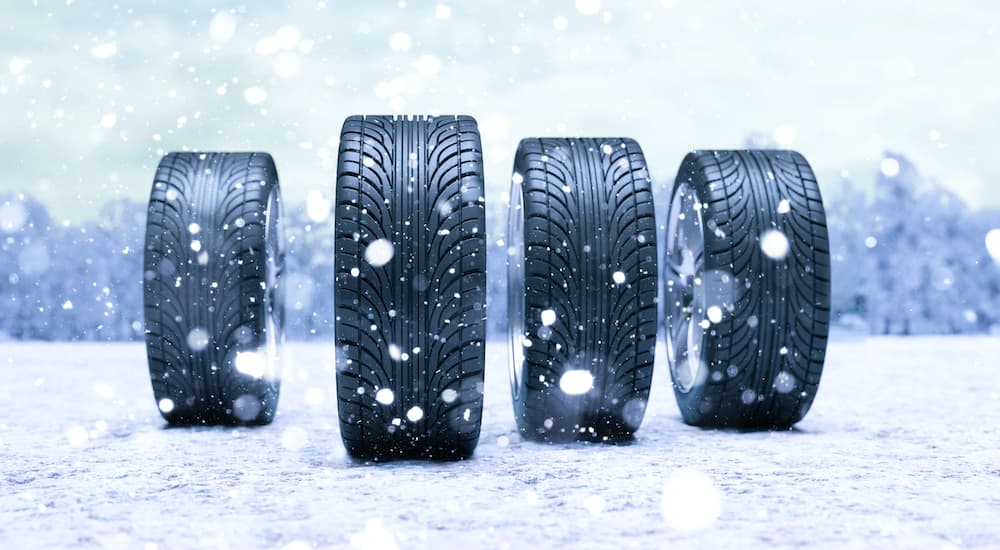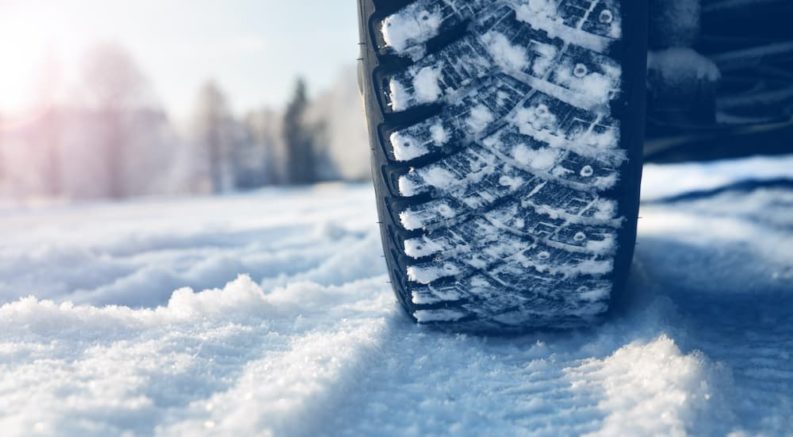Switching to winter tires is a smart move, especially if you set out to find the best price on high-quality discount tires. Many drivers fail to switch out their summer tires for a more appropriate winter version because they either a) think it’s unnecessary or b) think it’s expensive. Actually, winter tires are both affordable and a really good idea.
Unsure if you need a set of new winter shoes for your car? Winter weather breeds unsafe road conditions, and without a good set of winter tires, you’re rolling the dice. Traction control and all-wheel drive can only do so much – at the end of the day, your tires are making contact with the road, so you have to count on them to perform in dicey driving conditions.
What constitutes a good, high-quality winter tire? Experts agree that a winter tire’s tread pattern is critical, as is the flexibility of its rubber layer. Line them up side-by-side, and you can immediately see the chunkier tread pattern on a winter tire. By contrast, the sleeker and firmer summer tire is designed for sticky street performance. Don’t get caught out in the cold with the wrong tires this winter. Here are our favorite winter tire brands.
Michelin X-Ice Xi3
These long-timers are a perennial favorite for one main reason: they’re well-rounded. Part of the larger X-Ice tire lineup, the Xi3 is a couple of generations removed from the newest version, which makes them a bargain. They’re designed to tackle ice and snow and are sized for sedans and small crossovers. One important note: the Xi3’s are not available in the range of sizes found in other competitive tires.
The X-Ice Xi3 features a silica-based rubber compound that’s designed to stay firm in warmer temperatures, which is perfect for dry or rainy roads and adopts a more flexible characteristic when the mercury drops. The tread pattern is ideally suited for snow and slush evacuation, and the tires do an especially good job of helping drivers avoid hydroplaning in wet conditions.
The X-Ice Xi3 features signature Cross Z Sipes intended to provide stability laterally. They also feature a stiffer design that extends tire life and evens out tread wear. Stiffer tires translate into good road manners on dry pavement. The manufacturer recommends only installing these tires in sets of four, which is a good rule of thumb for any tire swap. The X-Ice Xi3 tires are available in 15, 16, 17, and 18-inch diameters.
The Michelin X-Ice Xi3 fares well in comparative testing, landing on Car and Driver’s list of best winter tires and getting high marks for performance in snowy conditions. They also outperform several leading competitors in dry/wet track side-by-side comparisons, and most reviewers cite their impressive quiet road manners. Michelin is a trusted brand, so picking up a set of the company’s X-Ice line of winter tires is an easy decision.

Bridgestone Blizzak WS90
Bridgestone is one of the most trusted tire brands overall, but their winter tires offer buyers a budget-friendly alternative with little to no reduction in cold weather performance. They’re especially effective in icy conditions, which are generally the most perilous. Putting a set of Blizzak WS90 tires on your car will get you through the winter months safely. These winter tires utilize bite particles that grab onto snowy roads a little more effectively and a multi-cell compound that Bridgestone reports displaces the water that typically builds up as the tire travels over snow and ice. They also boast a larger contact area and more flexibility for better overall performance, especially on ice.
The Blizzak WS90 is available in multiple sizes (51 in total), making them a great choice for just about any vehicle. Car and Driver report that they’re noisier than other winter tires, but give them a big thumb’s up for deep snow performance. These tires have an updated tread design and deliver a longer tread life than previous Blizzak versions. The WS90’s tread design features a three-dimensional sipe pattern that displaces snow highly efficiently, helping more of the tire’s surface stay in contact with the road. Two water channels are responsible for sucking water out of the treads continuously, and special biting edges take the stress out of winter cornering.
Continental Viking Contact 7
Viking is an accurate name for this durable winter tire. At home in the harshest snow and ice conditions, the Viking Contact 7 takes the stress out of snowy roads. Designed for sole duty as a winter tire, the Viking Contact 7 was tested in Scandinavia, receiving high marks in even the coldest sub-zero conditions. Most agree this tire is among the most pliable of all: that extra flexibility combines with the tire’s studless directional tread and varying sipes and tread grooves to provide more grip. Altogether, these tires are specifically designed to hold snow (which paradoxically helps with traction when driving over more snow).
The Continental gets high marks for road manners, too. It uses ContiSilent Technology that ensures minimal road noise. In fact, it has the lowest sound level criteria of any winter tire. All the while, the Viking Contact 7 meets rapidly changing road conditions with ease. Whether you’re slogging through a few inches of slush, turning through a puddle, or heading out right after a fresh coating of snow, these tires will perform consistently.
Opt for a set of Viking Contact 7 tires with run-flat ContiSeal Technology, and you can forget ever having to change a tire in a snowstorm, but even if you don’t, Continental has you covered. The company offers three years of complimentary roadside assistance along with a lengthy 12-month warranty and a 60-day trial. We’re pretty sure you won’t be returning these tires once you’ve driven on them.

How to Choose the Best Winter Tires
Tire technology continues to evolve so quickly that it’s almost impossible to find a tire that doesn’t perform as advertised. That’s good news for winter tire shoppers because the list of available options is endless. Not only that, but tire manufacturers routinely introduce new versions of old favorites, so model numbers can get confusing.
The best option is to do your research. Take a few hours and google around to local tire shops and trusted reviewers. Look for brands that show up on multiple reviewers’ “best of” lists. You can also do a little digging and see if your vehicle’s manufacturer or the local certified dealer recommends a specific brand. The more time you devote to your research, the more likely you are to uncover the best tires for your car.
Don’t be afraid to price shop: high-quality winter tires exist across a broad price spectrum, so unless you’re outfitting a high-performance sports car or some other specialty vehicle, finding a mid-priced set is perfectly acceptable. It’s always a good idea to buy from your installer for continuity, but it’s not necessary to ensure a quality installation.
Most of all, don’t forget that winter tires are designed for winter-only use. When spring arrives, swap them out for a set of summer tires. High temperatures will wear down your winter tires fast, and you will experience a decline in both performance and cornering. Because of your winter tires’ thicker tread, you’ll also experience a minor reduction in fuel economy. Trust us – swap them out when the snow melts.

